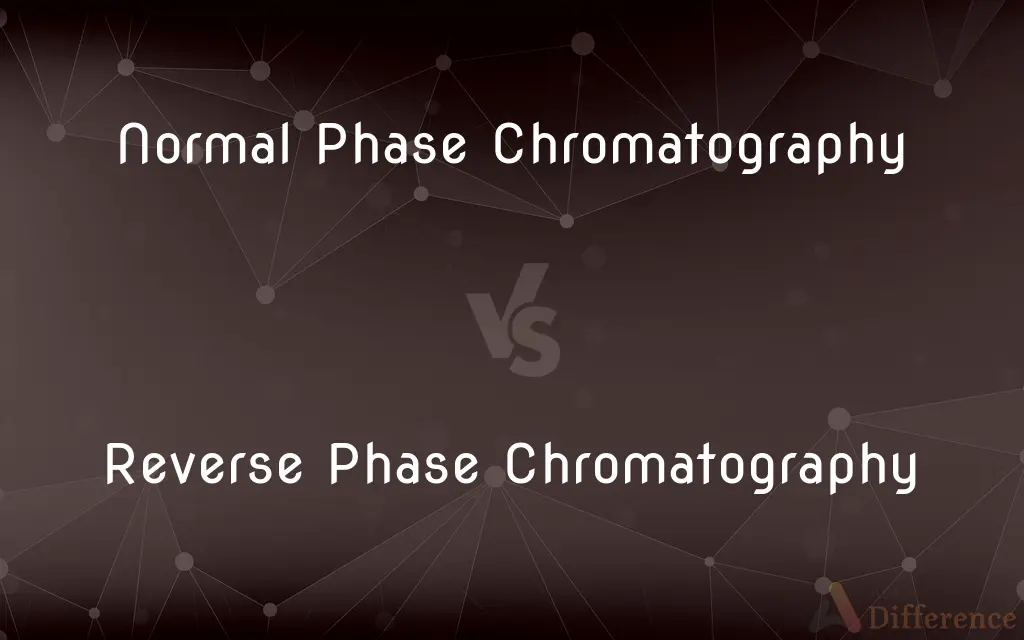Normal Phase Chromatography vs. Reverse Phase Chromatography — What's the Difference?
Edited by Tayyaba Rehman — By Fiza Rafique — Published on December 12, 2023
In Normal Phase Chromatography, polar stationary phases and non-polar mobile phases are used; Reverse Phase Chromatography employs non-polar stationary phases and polar mobile phases.

Difference Between Normal Phase Chromatography and Reverse Phase Chromatography
Table of Contents
ADVERTISEMENT
Key Differences
Normal Phase Chromatography and Reverse Phase Chromatography are both techniques used for the separation of compounds, but they operate on different principles. Normal Phase Chromatography involves a polar stationary phase and a non-polar mobile phase. When compounds pass through this setup, those that are more polar tend to adhere to the stationary phase, causing them to elute more slowly.
In contrast, Reverse Phase Chromatography works in the opposite manner. The stationary phase is non-polar, while the mobile phase is polar. In this setup, compounds that are less polar adhere more strongly to the stationary phase and elute more slowly. It's essentially the inverse of the normal phase approach.
Despite their differences, both Normal Phase Chromatography and Reverse Phase Chromatography are powerful tools for analytical chemists. The choice between them often depends on the nature of the compounds being studied. Normal Phase Chromatography is generally used when dealing with polar compounds, whereas Reverse Phase Chromatography is more suitable for less polar or hydrophobic compounds.
Understanding the properties of the sample and the desired outcome can help determine which method to employ. For example, if one wishes to separate compounds based on their polarity, Normal Phase Chromatography might be the better option. However, for samples where non-polar interactions play a larger role, Reverse Phase Chromatography may be more appropriate.
In essence, while both techniques serve to separate mixtures, they do so by exploiting different chemical affinities. Normal Phase Chromatography focuses on polar interactions, whereas Reverse Phase Chromatography centers on non-polar interactions.
ADVERTISEMENT
Comparison Chart
Stationary Phase
Polar
Non-polar
Mobile Phase
Non-polar
Polar
Preferred Compound Type
Polar compounds
Non-polar or hydrophobic compounds
Principle
Separation based on polar interactions
Separation based on non-polar interactions
Typical Use
Suitable for very polar compounds
Commonly used in peptide and protein separations
Compare with Definitions
Normal Phase Chromatography
Often chosen for polar compounds.
Given the compound's polarity, Normal Phase Chromatography was deemed best.
Reverse Phase Chromatography
Utilizes a non-polar stationary phase.
For the hydrophobic sample, Reverse Phase Chromatography was ideal.
Normal Phase Chromatography
Uses a polar stationary phase.
The scientist selected Normal Phase Chromatography for the polar sample.
Reverse Phase Chromatography
Elutes polar compounds faster.
In his Reverse Phase Chromatography experiment, the polar compound was the first to come out.
Normal Phase Chromatography
Involves a non-polar mobile phase.
Non-polar solvents function as mobile phases in Normal Phase Chromatography.
Reverse Phase Chromatography
Centers on non-polar interactions for separation.
The chemist used Reverse Phase Chromatography to explore the sample's non-polar characteristics.
Normal Phase Chromatography
Separates compounds based on polar interactions.
To differentiate the polarities of the mixture, she opted for Normal Phase Chromatography.
Reverse Phase Chromatography
Suitable for hydrophobic or non-polar compounds.
The lipid sample was best separated using Reverse Phase Chromatography.
Normal Phase Chromatography
Elutes non-polar compounds more rapidly.
In her Normal Phase Chromatography setup, the non-polar compound eluted first.
Reverse Phase Chromatography
Employs a polar mobile phase.
Water often acts as a component of the mobile phase in Reverse Phase Chromatography.
Common Curiosities
Which chromatography type is best for polar compounds?
Normal Phase Chromatography is typically chosen for polar compounds.
Are hydrophobic compounds better suited for Reverse Phase Chromatography?
Yes, hydrophobic or non-polar compounds are often separated using Reverse Phase Chromatography.
What mobile phase is used in Normal Phase Chromatography?
A non-polar mobile phase is used.
How does the stationary phase in Reverse Phase Chromatography differ?
It employs a non-polar stationary phase.
How does the mobile phase of Reverse Phase Chromatography differ?
It involves a polar mobile phase.
Are the stationary and mobile phases opposite in these two chromatography types?
Yes, what is polar in Normal Phase Chromatography is non-polar in Reverse Phase Chromatography and vice versa.
What stationary phase does Normal Phase Chromatography use?
It uses a polar stationary phase.
In which chromatography type would a polar compound elute faster?
In Reverse Phase Chromatography, polar compounds typically elute faster.
Which technique elutes non-polar compounds more rapidly?
Normal Phase Chromatography elutes non-polar compounds more quickly.
Can both chromatography types be used for any sample?
While both can be used for a variety of samples, the choice depends on the sample's properties and the desired separation.
Is one method superior to the other?
Neither is universally superior; the choice depends on the sample type and the desired separation outcome.
Are there any samples unsuitable for Normal Phase Chromatography?
Very non-polar samples might not yield efficient separations with Normal Phase Chromatography.
Can both chromatography methods be used in tandem?
Yes, they can be used sequentially to achieve more comprehensive separations.
Which technique is more common for protein separation?
Reverse Phase Chromatography is commonly used for peptide and protein separations.
Which chromatography has a greater risk of sample loss due to strong interactions?
Reverse Phase Chromatography, as some polar samples might strongly bind to the non-polar stationary phase.
Share Your Discovery

Previous Comparison
Active Transport vs. Passive Transport
Next Comparison
Object in English Grammar vs. Complement in English GrammarAuthor Spotlight
Written by
Fiza RafiqueFiza Rafique is a skilled content writer at AskDifference.com, where she meticulously refines and enhances written pieces. Drawing from her vast editorial expertise, Fiza ensures clarity, accuracy, and precision in every article. Passionate about language, she continually seeks to elevate the quality of content for readers worldwide.
Edited by
Tayyaba RehmanTayyaba Rehman is a distinguished writer, currently serving as a primary contributor to askdifference.com. As a researcher in semantics and etymology, Tayyaba's passion for the complexity of languages and their distinctions has found a perfect home on the platform. Tayyaba delves into the intricacies of language, distinguishing between commonly confused words and phrases, thereby providing clarity for readers worldwide.












































